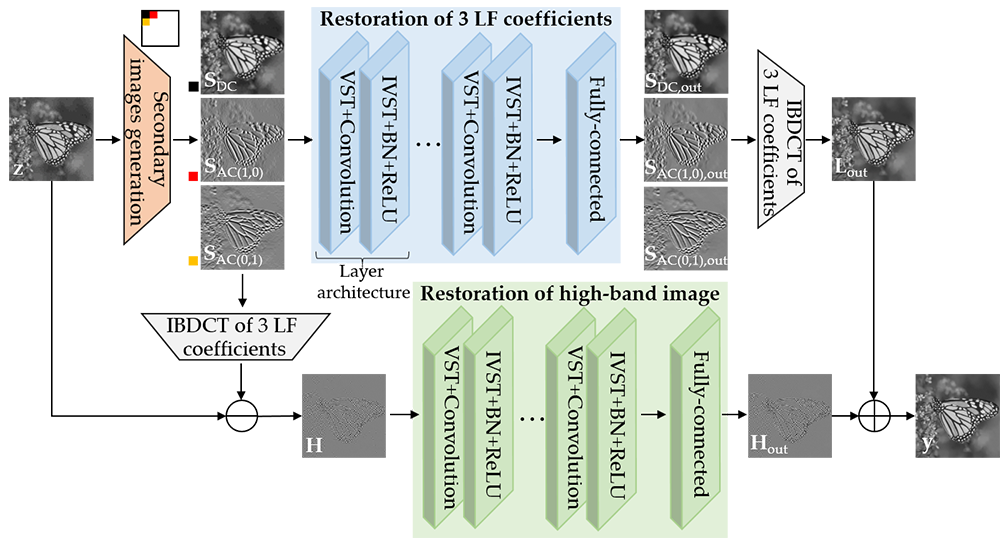In real image coding systems, a block-based coding is often applied on images contaminated by camera sensor noises such as Poisson noises and this causes complicated types of noises called compressed Poisson noises. Although many restoration methods were recently proposed for compressed images, they do not provide satisfactory performance on the challenging compressed Poisson Noises. This is mainly due to (i) inaccurate modeling regarding the image degradation, (ii) the signal-dependent noise property, and (iii) the lack of analysis on an intercorrelation distortion. In this paper, we focus on the challenging issues in practical image coding systems and propose a compressed Poisson noise reduction scheme based on secondary domain intercorrelation enhanced network. Specifically, we introduce a compressed Poisson noise corruption model and combine the secondary domain intercorrelation prior with a deep neural network specially designed for signal-dependent compression noise reduction. Experimental results show the proposed network is superior to existing state-of-the-art restoration alternatives on classical images, the LIVE1 dataset, and the SIDD dataset.
- compressed Poisson noises
- signal-dependent noise property
- intercorrelation
- deep neural network
To reflect the defined image degradation model in the neural network adequately, in this paper, we suggest a secondary domain intercorrelation enhanced network (SCENet) which is quite suitable to address compressed Poisson noises, as illustrated in Figure 3. Inspired by our preliminary examination, we adapt and extend the secondary domain approach [1] that is still valuable for recovering the intercorrelation distortion. Note that the proposed algorithm has a clear difference from the existing algorithm [1] in terms of method and application. In specific, while the classical edge-preserving total variation (TV) filtering is applied in the secondary domain for removing well-known blocking artifacts in [1], we utilize the deep neural network specially trained for reducing compressed Poisson noises, instead of the classical filtering. We also exploit the variance-stabilizing model to deal with signal-dependent noise characteristics. In other words, we combine key elements of VST-based secondary domain intercorrelation model with a deep neural network particularly trained using the defined compressed Poisson noise model. The proposed SCENet architecture has two major parallel phases, restoration of three LF coefficients and restoration of high-band (HB) image.

Figure 1. The architecture of the secondary domain intercorrelation enhanced network.
In one of the parallel phases, we increase the intercorrelation of DC, AC(1,0), and AC(0,1) in the secondary domain, as shown in the top of Figure 1. In specific, the network has 20 layer architectures and each layer architecture is composed of five operations: VST, convolution, inverse VST (IVST), batch normalization (BN), and rectified linear units (ReLU). For an input image z, we first generate three secondary images, SDC, SAC(1,0), and SAC(0,1). To this end, we compute three LF BDCT coefficients in each 8×8 block by shifting the block pixel-by-pixel with overlapping and then merge them into each secondary image, respectively. After that, to remove the signal dependency of compressed noises, the secondary image pixel value s is stabilized to have homoscedastic variance via the Anscombe transformation [2]. As a subsequent procedure, the convolution is done with K pre-trained filters, aL,F , with a size of W×H. Next, destabilization based on the IVST is applied in order to retrieve the original heteroskedastic variance. The IVST step is then followed by BN and ReLU for fast and stable convergence in the training process. The iterative layer architectures are performed on three secondary images separately for the adaptive restoration of each coefficient that has different quantization amounts. Final feature maps are reshaped to the original input tensor size via a fully-connected layer and then an output low-band (LB) image Lout is obtained by applying T−1 to three filtered coefficients, SDC,out, SAC(1,0),out, and SAC(0,1),out, in each block without overlapping. The images from the first column to the fourth column of Figure 4 show the three LF coefficients restoration network successfully recovers the secondary images and the LB image, similarly to their corresponding GT images by addressing artifacts in degraded images. In another parallel phase for restoring the HB image, we first obtain the input LB image L by applying T−1 to three LF coefficients in each 8×8 block. The input HB image H is then acquired by subtracting L from the input image z. Note that H corresponds to the remaining 61 HF coefficients in each block. Next, the filtered output Hout is computed via the same iterative layer architectures as in the restoration of three LF coefficients, by using convolution filters bL instead of aL,F.
References
- Seok Bong Yoo; Kyuha Choi; Jong Beom Ra; Post-Processing for Blocking Artifact Reduction Based on Inter-Block Correlation. IEEE Transactions on Multimedia 2014, 16, 1536-1548, 10.1109/tmm.2014.2327563.
- Markku Mäkitalo; Alessandro Foi; Optimal inversion of the Anscombe transformation in low-count Poisson image denoising.. IEEE Transactions on Image Processing 2011, 20, 99-109, 10.1109/TIP.2010.2056693.
 Encyclopedia
Encyclopedia

